Structural Performance of Energy Efficient Geopolymer Concrete Confined Masonry: An Approach towards Decarbonization
Abstract
1. Introduction
2. Methodology
2.1. Experimental Setup
2.1.1. Test Specimens and Geometric Properties
2.1.2. Materials and Properties
2.1.3. Instrumentation and Test Procedure
2.2. Numerical Simulation
3. Results and Discussions
3.1. Experimental Program
3.1.1. Material Behavior
3.1.2. Hysteretic Response
3.1.3. Strain in Longitudinal Reinforcement
3.1.4. Failure Mechanism
3.2. Numerical Modeling
4. Comparison of Seismic Parameters
5. Viability of Geopolymer Concrete
6. Conclusions
Author Contributions
Funding
Data Availability Statement
Acknowledgments
Conflicts of Interest
References
- Almssad, A.; Almusaed, A.; Homod, R.Z. Masonry in the Context of Sustainable Buildings: A Review of the Brick Role in Architecture. Sustainability 2022, 14, 14734. [Google Scholar] [CrossRef]
- Borah, B.; Kaushik, H.B.; Singhal, V. Lateral load-deformation models for seismic analysis and performance-based design of confined masonry walls. J. Build. Eng. 2022, 48, 103978. [Google Scholar] [CrossRef]
- Macabuag, J.; Guragain, R.; Bhattacharya, S. Seismic retrofitting of non-engineered masonry in rural Nepal. Proc. Inst. Civ. Eng. Build. 2012, 165, 273–286. [Google Scholar] [CrossRef]
- Bhattacharya, S.; Nayak, S.; Dutta, S.C. A critical review of retrofitting methods for unreinforced masonry structures. Int. J. Disaster Risk Reduct. 2014, 7, 51–67. [Google Scholar] [CrossRef]
- Varela-Rivera, J.; Fernandez-Baqueiro, L.; Gamboa-Villegas, J.; Prieto-Coyoc, A.; Moreno-Herrera, J. Flexural behavior of confined masonry walls subjected to in-plane lateral loads. Earthq. Spectra 2019, 35, 405–422. [Google Scholar] [CrossRef]
- Bruneau, M. State-of-the-art report on seismic performance of unreinforced masonry buildings. J. Struct. Eng. 1994, 120, 230–251. [Google Scholar] [CrossRef]
- So, E.K.M.; Pomonis, A. Derivation of globally applicable casualty rates for use in earthquake loss estimation models. In Proceedings of the 15th World Conference on Earthquake Engineering, USB, Lisbon, Portugal, 24–28 September 2012. [Google Scholar]
- Asian Development Bank and World Bank (ADB-WB). Preliminary Damage and Needs Assessment-Pakistan 2005 Earthquake; Asian Development Bank and World Bank: Islamabad, Pakistan, 2005. [Google Scholar]
- Naseer, A.; Khan, A.N.; Hussain, Z.; Ali, Q. Observed seismic behavior of buildings in northern Pakistan during the 2005 Kashmir earthquake. Earthq. Spectra 2010, 26, 425–449. [Google Scholar] [CrossRef]
- Marques, R.; Lourenço, P.B. A model for pushover analysis of confined masonry structures: Implementation and validation. Bull. Earthq. Eng. 2013, 11, 2133–2150. [Google Scholar] [CrossRef]
- Meli, R. Structural design of masonry buildings: The Mexican practice. Spec. Publ. 1994, 147, 239–262. [Google Scholar]
- Gallegos, H. Masonry in Peru. Spec. Publ. 1994, 147, 307–332. [Google Scholar]
- Alcocer, S.M.; Klingner, R.E. Masonry research in the Americas. Spec. Publ. 1994, 147, 127–170. [Google Scholar]
- Hidalgo, P.A. Seismic behavior and earthquake-resistant design of masonry buildings in Chile. Spec. Publ. 1994, 147, 333–356. [Google Scholar]
- Garcia, L.E.; Yamin, L.E. Review of Masonry Construction in Columbia. Spec. Publ. 1994, 147, 283–306. [Google Scholar]
- ElGawady, M.; Lestuzzi, P.; Badoux, M. A review of conventional seismic retrofitting techniques for URM. In Proceedings of the 13th International Brick and Block Masonry Conference, Amsterdam, The Netherlands, 4–7 July 2004; pp. 1–10. [Google Scholar]
- Tomazevic, M. Earthquake-Resistant Design of Masonry Buildings; World Scientific: Singapore, 1999; Volume 1. [Google Scholar]
- Brzev, S.; Meli, R. International guideline for seismic design of low-rise confined masonry buildings in regions of high seismic risk. In Proceedings of the 15th World Conference Earthquake Engineering, Lisabon, Portugal, 24–28 September 2012. [Google Scholar]
- Yekrangnia, M.; Bakhshi, A.; Ghannad, M.A. Force-displacement model for solid confined masonry walls with shear-dominated failure mode. Earthq. Eng. Struct. Dyn. 2017, 46, 2209–2234. [Google Scholar] [CrossRef]
- Najafgholipour, M.A.; Maheri, M.R.; Khajepour, M. Performance of confined masonry buildings in November 2017, Sarpole Zahab earthquake (Mw = 7.3), Iran. Bull. Earthq. Eng. 2022, 20, 4065–4095. [Google Scholar] [CrossRef]
- Boen, T.; Pribadi, K.S. Engineering the non-engineered houses for better earthquake resistance in Indonesia. In Proceedings of the DRH Contents Meeting-EDMNIED 2007, Kobe, Japan, 12–13 March 2007; Volume 7. [Google Scholar]
- Qazi, A.U.; Rasool, A.M.; Ibrahim, Y.E.; Hameed, A.; Ali, M.F. Behavior of Scaled Infilled Masonry, Confined Masonry & Reinforced Concrete Structures under Dynamic Excitations. Buildings 2022, 12, 774. [Google Scholar]
- Hori, N.; Inoue, N.; Purushotam, D.; Nishida, T.; Kobayashi, J. Experimental and analytical studies on earthquake resisting behaviour of confined concrete block masonry structures. Earthq. Eng. Struct. Dyn. 2006, 35, 1699–1719. [Google Scholar] [CrossRef]
- Marques, R.; Lourenço, P.B. Structural behaviour and design rules of confined masonry walls: Review and proposals. Constr. Build. Mater. 2019, 217, 137–155. [Google Scholar] [CrossRef]
- Huang, L.; Lu, Y.; Yan, L.; Kasal, B.; Wang, L.; Zhang, T. Seismic performance of mortarless reinforced masonry walls. J. Build. Eng. 2020, 31, 101368. [Google Scholar] [CrossRef]
- Jain, S.K.; Basu, D.; Ghosh, I.; Rai, D.C.; Brzev, S.; Bhargava, L.K. Application of confined masonry in a major project in India. In Proceedings of the NCEE 2014–10th U.S. National Conference on Earthquake Engineering Frontiers of Earthquake Engineering, Anchorage, AK, USA, 21–25 July 2014. [Google Scholar] [CrossRef]
- Zhou, Y.; Zheng, S.; Chen, L.; Long, L.; Dong, L. Mechanical properties and seismic behavior of confined masonry walls in freeze-thaw environment. Structures 2021, 31, 647–659. [Google Scholar] [CrossRef]
- Yoshimura, K.; Kikuchi, K.; Kuroki, M.; Nonaka, H.; Kim, K.T.; Wangdi, R.; Oshikata, A. Experimental study for developing higher seismic performance of brick masonry walls. In Proceedings of the 13th World Conference on Earthquake Engineering, Vancouver, BC, Canada, 1–6 August 2004. Paper, 1597. [Google Scholar]
- Tomaževič, M.; Klemenc, I. Seismic behaviour of confined masonry walls. Earthq. Eng. Struct. Dyn. 1997, 26, 1059–1071. [Google Scholar] [CrossRef]
- Borah, B.; Singhal, V.; Kaushik, H.B. Sustainable housing using confined masonry buildings. SN Appl. Sci. 2019, 1, 983. [Google Scholar] [CrossRef]
- Erberik, M.A.; Citiloglu, C.; Erkoseoglu, G. Seismic performance assessment of confined masonry construction at component and structure levels. Bull. Earthq. Eng. 2019, 17, 867–889. [Google Scholar] [CrossRef]
- Gouveia, J.P.; Lourenço, P.B. Masonry shear walls subjected to cyclic loading: Influence of confinement and horizontal reinforcement. In Proceedings of the North American Masonry Conference, St. Luis, MI, USA, 3–5 June 2007. [Google Scholar]
- Brzev, S. Earthquake-Resistant Confined Masonry Construction; NICEE, National Information Center of Earthquake Engineering, IIT Kanpur: Kanpur, India, 2007. [Google Scholar]
- Sharma, P.; Verma, M.; Sharma, N. Examine the mechanical properties of recycled coarse aggregate with MK GGBS. In Proceedings of the IOP Conference Series: Materials Science and Engineering, Sanya, China, 2–14 November 2021; Volume 1116, p. 12152. [Google Scholar]
- Verma, M.; Sharma, N.; Sharma, P.; Singh, P. Evaluate the Effect in Terms of Setting Time and Compressive Strength of Oleic Acid as an Admixture in Cement. Test Eng. Manag. 2020, 12422, 12422–12427. [Google Scholar]
- Nagar, P.A.; Gupta, N.; Kishore, K.; Parashar, A.K. Coupled effect of B. Sphaericus bacteria and calcined clay mineral on OPC concrete. Mater. Today Proc. 2021, 44, 113–117. [Google Scholar] [CrossRef]
- Kishore, K.; Gupta, N. Application of domestic & industrial waste materials in concrete: A review. Mater. Today Proc. 2020, 26, 2926–2931. [Google Scholar]
- Sharma, P.; Sharma, N.; Singh, P.; Verma, M.; Parihar, H.S. Examine the effect of setting time and compressive strength of cement mortar paste using iminodiacetic acid. Mater. Today Proc. 2020, 32, 878–881. [Google Scholar] [CrossRef]
- Gupta, N.; Gupta, A.; Saxena, K.K.; Shukla, A.; Goyal, S.K. Mechanical and durability properties of geopolymer concrete composite at varying superplasticizer dosage. Mater. Today Proc. 2021, 44, 12–16. [Google Scholar] [CrossRef]
- Barcelo, L.; Kline, J.; Walenta, G.; Gartner, E. Cement and carbon emissions. Mater. Struct. 2014, 47, 1055–1065. [Google Scholar] [CrossRef]
- Bosoaga, A.; Masek, O.; Oakey, J.E. CO2 capture technologies for cement industry. Energy Procedia 2009, 1, 133–140. [Google Scholar] [CrossRef]
- Malhotra, V.M. Introduction: Sustainable development and concrete technology. Concr. Int. 2002, 24, 7. [Google Scholar]
- Yıldırım, G.; Kul, A.; Özçelikci, E.; Şahmaran, M.; Aldemir, A.; Figueira, D.; Ashour, A. Development of alkali-activated binders from recycled mixed masonry-originated waste. J. Build. Eng. 2021, 33, 101690. [Google Scholar] [CrossRef]
- Aprianti, E.; Shafigh, P.; Bahri, S.; Farahani, J.N. Supplementary cementitious materials origin from agricultural wastes–A review. Constr. Build. Mater. 2015, 74, 176–187. [Google Scholar] [CrossRef]
- Kishore, K.; Gupta, N. Mechanical characterization and assessment of composite geopolymer concrete. Mater. Today Proc. 2021, 44, 58–62. [Google Scholar] [CrossRef]
- Parashar, A.K.; Gupta, A. Investigation of the effect of bagasse ash, hooked steel fibers and glass fibers on the mechanical properties of concrete. Mater. Today Proc. 2021, 44, 801–807. [Google Scholar] [CrossRef]
- Parashar, A.K.; Gupta, A. Experimental study of the effect of bacillus megaterium bacteria on cement concrete. IOP Conf. Ser. Mater. Sci. Eng. 2021, 1116, 12168. [Google Scholar] [CrossRef]
- Mehta, P.K. Concrete Technology for a Sustainable Development in the 21st Century; CRC Press: Boca Raton, FL, USA, 1999; Volume 83. [Google Scholar]
- Van Oss, H.G.; Padovani, A.C. Cement manufacture and the environment part II: Environmental challenges and opportunities. J. Ind. Ecol. 2003, 7, 93–126. [Google Scholar]
- Li, C.; Gong, X.Z.; Cui, S.P.; Wang, Z.H.; Zheng, Y.; Chi, B.C. CO2 emissions due to cement manufacture. Mater. Sci. Forum 2011, 685, 181–187. [Google Scholar] [CrossRef]
- De Brito, J.; Saikia, N. Recycled Aggregate in Concrete: Use of Industrial, Construction and Demolition Waste; Springer Science & Business Media: Berlin/Heidelberg, Germany, 2012. [Google Scholar]
- Diaz-Loya, E.I.; Allouche, E.N.; Vaidya, S. Mechanical properties of fly-ash-based geopolymer concrete. ACI Mater. J. 2011, 108, 300. [Google Scholar]
- Yildirim, H.; Sümer, M.; Akyüncü, V.; Gürbüz, E. Comparison on efficiency factors of F and C types of fly ashes. Constr. Build. Mater. 2011, 25, 2939–2947. [Google Scholar] [CrossRef]
- Duxson, P.; Provis, J.L.; Lukey, G.C.; Van Deventer, J.S.J. The role of inorganic polymer technology in the development of ‘green concrete’. Cem. Concr. Res. 2007, 37, 1590–1597. [Google Scholar] [CrossRef]
- Albitar, M.; Ali, M.S.M.; Visintin, P. Experimental study on fly ash and lead smelter slag-based geopolymer concrete columns. Constr. Build. Mater. 2017, 141, 104–112. [Google Scholar] [CrossRef]
- Kaya, M.; Koksal, F.; Gencel, O.; Munir, M.J.; Kazmi, S.M.S. Influence of micro Fe2O3 and MgO on the physical and mechanical properties of the zeolite and kaolin based geopolymer mortar. J. Build. Eng. 2022, 52, 104443. [Google Scholar] [CrossRef]
- Panagiotopoulou, C.; Kontori, E.; Perraki, T.; Kakali, G. Dissolution of aluminosilicate minerals and by-products in alkaline media. J. Mater. Sci. 2007, 42, 2967–2973. [Google Scholar] [CrossRef]
- Rangan, B.V. Fly Ash-Based Geopolymer Concrete; Curtin University of Technology: Perth, WA, Australia, 2008. [Google Scholar]
- Marín-López, C.; Araiza, J.L.R.; Manzano-Ramírez, A.; Avalos, J.C.R.; Perez-Bueno, J.J.; Muñiz-Villareal, M.S.; Ventura-Ramos, E.; Vorobiev, Y. Synthesis and characterization of a concrete based on metakaolin geopolymer. Inorg. Mater. 2009, 45, 1429–1432. [Google Scholar] [CrossRef]
- Okoye, F.N.; Durgaprasad, J.; Singh, N.B. Effect of silica fume on the mechanical properties of fly ash based-geopolymer concrete. Ceram. Int. 2016, 42, 3000–3006. [Google Scholar] [CrossRef]
- Mathew, B.J.; Sudhakar, M.; Natarajan, C. Strength, economic and sustainability characteristics of coal ash–GGBS based geopolymer concrete. Int. J. Comput. Eng. Res. 2013, 3, 207–212. [Google Scholar]
- Detphan, S.; Chindaprasirt, P. Preparation of fly ash and rice husk ash geopolymer. Int. J. Miner. Metall. Mater. 2009, 16, 720–726. [Google Scholar]
- Ojha, A.; Aggarwal, P. Fly ash based geopolymer concrete: A comprehensive review. Silicon 2022, 14, 2453–2472. [Google Scholar] [CrossRef]
- Huang, Y.-J.; Guo, F.; Zhang, H.; Yang, Z. An Efficient Computational Framework for Generating Realistic 3D Mesoscale Concrete Models Using Micro X-Ray Computed Tomography Images and Dynamic Physics Engine. Cem. Concr. Compos. 2022, 126, 104347. [Google Scholar] [CrossRef]
- Albitar, M.; Visintin, P.; Ali, M.S.M.; Lavigne, O.; Gamboa, E. Bond slip models for uncorroded and corroded steel reinforcement in class-F fly ash geopolymer concrete. J. Mater. Civ. Eng. 2017, 29, 4016186. [Google Scholar] [CrossRef]
- Yu, R.; Spiesz, P.; Brouwers, H.J.H. Development of an eco-friendly Ultra-High Performance Concrete (UHPC) with efficient cement and mineral admixtures uses. Cem. Concr. Compos. 2015, 55, 383–394. [Google Scholar] [CrossRef]
- Sugama, T.; Pyatina, T. Effect of sodium carboxymethyl celluloses on water-catalyzed self-degradation of 200 °C-heated alkali-activated cement. Cem. Concr. Compos. 2015, 55, 281–289. [Google Scholar] [CrossRef]
- Ioannou, S.; Paine, K.; Reig, L.; Quillin, K. Performance characteristics of concrete based on a ternary calcium sulfoaluminate–anhydrite–fly ash cement. Cem. Concr. Compos. 2015, 55, 196–204. [Google Scholar] [CrossRef]
- Albitar, M.; Visintin, P.; Ali, M.S.M.; Drechsler, M. Assessing behaviour of fresh and hardened geopolymer concrete mixed with class-F fly ash. KSCE J. Civ. Eng. 2015, 19, 1445–1455. [Google Scholar] [CrossRef]
- Laskar, A.I.; Bhattacharjee, R. Effect of Plasticizer and Superplasticizer on Rheology of Fly-Ash-Based Geopolymer Concrete. ACI Mater. J. 2013, 110, 5. [Google Scholar]
- Albitar, M.; Ali, M.S.M.; Visintin, P.; Drechsler, M. Effect of granulated lead smelter slag on strength of fly ash-based geopolymer concrete. Constr. Build. Mater. 2015, 83, 128–135. [Google Scholar] [CrossRef]
- Fan, X.; Zhang, M. Experimental study on flexural behaviour of inorganic polymer concrete beams reinforced with basalt rebar. Compos. Part B Eng. 2016, 93, 174–183. [Google Scholar] [CrossRef]
- Kathirvel, P.; Kaliyaperumal, S.R.M. Influence of recycled concrete aggregates on the flexural properties of reinforced alkali activated slag concrete. Constr. Build. Mater. 2016, 102, 51–58. [Google Scholar] [CrossRef]
- Maranan, G.B.; Manalo, A.C.; Benmokrane, B.; Karunasena, W.; Mendis, P. Behavior of concentrically loaded geopolymer-concrete circular columns reinforced longitudinally and transversely with GFRP bars. Eng. Struct. 2016, 117, 422–436. [Google Scholar] [CrossRef]
- Yost, J.R.; Radlińska, A.; Ernst, S.; Salera, M. Structural behavior of alkali activated fly ash concrete. Part 1: Mixture design, material properties and sample fabrication. Mater. Struct. 2013, 46, 435–447. [Google Scholar] [CrossRef]
- ASTM C127-88(2001); Standard Test Method for Specific Gravity and Absorption of Coarse Aggregate 1; no. Reapproved. ASTM: West Conshohocken: PA, USA, 2001; Volume 4, pp. 1–5.
- Ghafoor, M.T.; Khan, Q.S.; Qazi, A.U.; Sheikh, M.N.; Hadi, M.N.S. Influence of alkaline activators on the mechanical properties of fly ash based geopolymer concrete cured at ambient temperature. Constr. Build. Mater. 2021, 273, 121752. [Google Scholar] [CrossRef]
- ASTM C 136-06; Standard Test Method for Sieve Analysis of Fine and Coarse Aggregates. ASTM: West Conshohocken, PA, USA, 2006; pp. 1–5. [CrossRef]
- ASTM C67-07; Standard Test Methods for Sampling and Testing Brick and Structural Clay Tile. ASTM International: West Conshohocken, PA, USA, 2007; Volume i, pp. 1–12. Available online: www.astm.org (accessed on 15 September 2022).
- ASTM C109; ASTM C109/C109M-20b: Standard Test Method for Compressive Strength of Hydraulic Cement Mortars (Using 2-inor [50 mm] Cube Specimens). Annual Book of ASTM Standards; ASTM: West Conshohocken, PA, USA, 2020; Volume 4, p. 9.
- Masonry Standards Joint Committee (MSJC) of the Masonry Society. Building Code Requirements for Masonry Structures (TMS 402-11/ACI 530-11/ASCE 6-11) and Specification for Masonry Structures (TMS 602-11/ACI 530.1-11/ASCE 5-11) and Companion Commentaries; American Concrete Institute: Farmington Hills, MI, USA, 2011. [Google Scholar]
- ASTM C39/C39M; Standard Test Method for Compressive Strength of Cylindrical Concrete Specimens 1. ASTM Stand. B; ASTM: West Conshohocken: PA, USA, 2003; Volume i, no. March. pp. 1–5.
- ASTM C469/C469M-10; Standard Test Method for Static Modulus of Elasticity and Poisson’s Ratio of Concrete in Compression. ASTM Stand. C; ASTM: West Conshohocken, PA, USA, 2010; Volume 469.
- IS 1608-2005; Metallic Materials-Tensile Testing at Ambient Temperature. Bur. Indian Stand.; Instron: Norwood, MA, USA, 2005.
- Lourenço, P.B. Computational Strategies for Masonry Structures. Doctoral Thesis, Delft University of Technology, Delft, The Netherlands, 1996. [Google Scholar]
- Kömürcü, S.; Gedikli, A. Macro and Micro Modelling of the Unreinforced Masonry Shear Walls. Eur. J. Eng. Nat. Sci. 2019, 3, 116–123. Available online: https://dergipark.org.tr/en/pub/ejens/issue/49410/369461 (accessed on 15 September 2022).
- Mynarz, M.; Mynarzova, L. Non-linear approaches to the response of brick masonry wall to lateral loading. Int. J. GEOMATE 2018, 14, 76–82. [Google Scholar] [CrossRef]
- Dhanasekar, M.; Elsalakawy, T. IJERT-Numerical Simulation of Masonry Prism Test Using ANSYS and ABAQUS Related Papers Review of Modelling of Masonry Shear Numerical Simulation of Masonry Prism Test Using ANSYS and ABAQUS. IJERT J. Int. J. Eng. Res. Technol. 2015, 4. Available online: www.ijert.org (accessed on 15 September 2022).
- Kanıt, R.; Döndüren, M.S. Investıgatıon of Usıng Ansys Software in the Determınatıon of Stress Behavıours of Masonry Walls under out of Plane Cyclıng Load. Int. J. Phys. Sci. 2010, 5, 97–108. Available online: http://www.academicjournals.org/IJPS (accessed on 15 September 2022).
- Magenes, G.; Della Fontana, A. Simplified non-linear seismic analysis of masonry buildings. Proc. Br. Masonry Soc. 1998, 8, 190–195. [Google Scholar]
- Vanin, A.; Foraboschi, P. Journal-Modelling of Masonry Panels by Truss Analogy--Part 1. Mason. Int. 2009, 22, 1. [Google Scholar]
- Tomaževič, M.; Gams, M. Shaking table study and modelling of seismic behaviour of confined AAC masonry buildings. Bull. Earthq. Eng. 2012, 10, 863–893. [Google Scholar] [CrossRef]
- Lagomarsino, S.; Penna, A.; Galasco, A.; Cattari, S. TREMURI program: An equivalent frame model for the nonlinear seismic analysis of masonry buildings. Eng. Struct. 2013, 56, 1787–1799. [Google Scholar] [CrossRef]
- Caliò, I.; Marletta, M.; Pantò, B. A new discrete element model for the evaluation of the seismic behaviour of unreinforced masonry buildings. Eng. Struct. 2012, 40, 327–338. [Google Scholar] [CrossRef]
- Ansys Inc. “Element Reference,” Volume 15317, No. November, p. 9, 2010. Available online: https://www.mm.bme.hu/~gyebro/files/fea/ansys/ansys_13_element_reference.pdf (accessed on 25 September 2022).
- Neupane, K.; Kidd, P.; Chalmers, D.; Baweja, D.; Shrestha, R. Investigation on compressive strength development and drying shrinkage of ambient cured powder-activated geopolymer concretes. Aust. J. Civ. Eng. 2016, 14, 72–83. [Google Scholar] [CrossRef]
- Reddy, P.C.; Ganesan, R. Comparative study of compressive strength of novel steel fiber reinforced geopolymer concrete and conventional concrete. Mater. Today Proc. 2023, 77, 504–508. [Google Scholar] [CrossRef]
- Razak, S.; Zainal, F.F.; Shamsudin, S.R. Effect of porosity and water absorption on compressive strength of fly ash based geopolymer and OPC Paste. IOP Conf. Ser. Mater. Sci. Eng. 2020, 957, 12035. [Google Scholar] [CrossRef]
- Bondar, D.; Lynsdale, C.J.; Milestone, N.B.; Hassani, N.; Ramezanianpour, A.A. Engineering properties of alkali-activated natural pozzolan concrete. ACI Mater. J. 2011, 108, 64–72. [Google Scholar]
- Olivia, M.; Nikraz, H. Properties of fly ash geopolymer concrete designed by Taguchi method. Mater. Des. 2012, 36, 191–198. [Google Scholar] [CrossRef]
- Nath, P.; Sarker, P.K. Flexural strength and elastic modulus of ambient-cured blended low-calcium fly ash geopolymer concrete. Constr. Build. Mater. 2017, 130, 22–31. [Google Scholar] [CrossRef]
- Ganesan, N.; Indira, P.V.; Irshad, P. Effect of ferrocement infill on the strength and behavior of RCC frames under reverse cyclic loading. Eng. Struct. 2017, 151, 273–281. [Google Scholar] [CrossRef]
- Li, B.; Wang, J.; Duan, M.; Guo, L.; Wang, B. Cyclic experimental and numerical analytical investigation of precast concrete frames with buckling-restrained braces considering various assembling connections. Structures 2021, 34, 1135–1153. [Google Scholar] [CrossRef]
- Lyu, H.; Deng, M.; Ma, Y.; Yang, S.; Cheng, Y. In-plane cyclic tests on strengthening of full-scale autoclaved aerated concrete blocks infilled RC frames using highly ductile concrete (HDC). J. Build. Eng. 2022, 49, 104083. [Google Scholar] [CrossRef]
- Sumajouw, D.M.J.; Hardjito, D.; Wallah, S.E.; Rangan, B.V. Fly ash-based geopolymer concrete: Study of slender reinforced columns. J. Mater. Sci. 2007, 42, 3124–3130. [Google Scholar] [CrossRef]
- Rahman, M.; Sarker, P. Geopolymer concrete columns under combined axial load and biaxial bending. In Proceedings of the Concrete 2011 Conference, Perth, WA, Australia, 12 October 2011. [Google Scholar]
- Borah, B.; Singhal, V.; Kaushik, H.B. Assessment of seismic design provisions for confined masonry using experimental and numerical approaches. Eng. Struct. 2021, 245, 112864. [Google Scholar] [CrossRef]
- El-Diasity, M.; Okail, H.; Kamal, O.; Said, M. Structural performance of confined masonry walls retrofitted using ferrocement and GFRP under in-plane cyclic loading. Eng. Struct. 2015, 94, 54–69. [Google Scholar] [CrossRef]
- Ahmed, A.; Ahmad, I.; Shahzada, K.; Naqash, M.T.; Alam, B.; Fahad, M.; Khan, S.W. Seismic Capacity Assessment of Confined Brick Masonry Building: An Experimental Approach. Shock. Vib. 2018, 2018, 4756352. [Google Scholar] [CrossRef]
- Gioffrè, M.; Cavalagli, N.; Gusella, V.; Pepi, C. Confined vs. unreinforced masonry: Construction and shaking table tests of two-storey buildings. Constr. Build. Mater. 2022, 333, 126961. [Google Scholar] [CrossRef]
- ASCE/SEI 41-06; Supplement to Seismic Rehabilitation of Existing Buildings. ASCE: Reston, VA, USA, 2007.
- Ashraf, M. Development of Low-Cost and Efficient Retrofitting Technique for Unreinforced Masonry Buildings. Ph.D. Dissertation, University of Engineering and Technology, Peshawar, Pakistan, 2010. [Google Scholar]
- Reboul, N.; Mesticou, Z.; Larbi, A.S.; Ferrier, E. Experimental study of the in-plane cyclic behaviour of masonry walls strengthened by composite materials. Constr. Build. Mater. 2018, 164, 70–83. [Google Scholar] [CrossRef]
- Hasnat, A.; Ahsan, R.; Yashin, S.M. Quasi-static in-plane behavior of full-scale unreinforced masonry walls retrofitted using ferro-cement overlay. Asian J. Civ. Eng. 2022, 23, 649–664. [Google Scholar] [CrossRef]
- Konthesingha, K.M.C.; Masia, M.J.; Petersen, R.B.; Page, A.W. Experimental evaluation of static cyclic in-plane shear behavior of unreinforced masonry walls strengthened with NSM FRP strips. J. Compos. Constr. 2015, 19, 4014055. [Google Scholar] [CrossRef]
- Mojsilović, N.; Simundic, G.; Page, A. Masonry wallettes with damp-proof course membrane subjected to cyclic shear: An experimental study. Constr. Build. Mater. 2010, 24, 2135–2144. [Google Scholar] [CrossRef]
- Aguilar, G.; Meli, R.; Diaz, R.; Vázquez-del-Mercado, R. Influence of horizontal reinforcement on the behavior of confined masonry walls. In Proceedings of the Eleventh World Conference on Earthquake Engineering, Acapulco, Mexico, 23–28 June 1996. [Google Scholar]
- Yáñez, F.; Astroza, M.; Holmberg, A.; Ogaz, O. Behavior of confined masonry shear walls with large openings. In Proceedings of the 13th World Conference on Earthquake Engineering, Vancouver, BC, Canada, 1–6 August 2004; Volume 3438. [Google Scholar]
- Marinilli, A.; Castilla, E. Experimental evaluation of confined masonry walls with several confining-columns. In Proceedings of the 13th World Conference on Earthquake Engineering, Vancouver, BC, Canada, 1–6 August 2004. [Google Scholar]
- Zabala, F.; Bustos, J.L.; Masanet, A.; Santalucia, J. Experimental behaviour of masonry structural walls used in Argentina. In Proceedings of the 13th World Conference on Earthquake Engineering, Vancouver, BC, Canada, 1–6 August 2004. [Google Scholar]
- Bourzam, A.; Goto, T.; Miyajima, M. Shear capacity prediction of confined masonry walls subjected to cyclic lateral loading. Doboku Gakkai Ronbunshuu A 2008, 64, 692–704. [Google Scholar] [CrossRef]
- Gavilan, J.J.P.; Flores, L.E.; Alcocer, S.M. An experimental study of confined masonry walls with varying aspect ratios. Earthq. Spectra 2015, 31, 945–968. [Google Scholar] [CrossRef]
- Tena-Colunga, A.; Juárez-Ángeles, A.; Salinas-Vallejo, V.H. Cyclic behavior of combined and confined masonry walls. Eng. Struct. 2009, 31, 240–259. [Google Scholar] [CrossRef]
- Kuang, J.S.; Wang, Z. Cyclic load tests of rc frame with column-isolated masonry infills. In Proceedings of the Second European Conference on Earthquake Engineering and Seismology, Istanbul, Turkey, 25–29 August 2014; pp. 25–29. [Google Scholar]
- Ozkaynak, H.; Yuksel, E.; Buyukozturk, O.; Yalcin, C.; Dindar, A.A. Quasi-static and pseudo-dynamic testing of infilled RC frames retrofitted with CFRP material. Compos. Part B Eng. 2011, 42, 238–263. [Google Scholar] [CrossRef]
- Van, T.C.; Lau, T.L. Experimental evaluation of reinforced concrete frames with unreinforced masonry infills under monotonic and cyclic loadings. Int. J. Civ. Eng. 2021, 19, 401–419. [Google Scholar] [CrossRef]
- Li, Y.; Zhu, J.; Wang, Z. Investigation on mechanical properties of masonry infill wall strengthened with ECC. KSCE J. Civ. Eng. 2019, 23, 295–306. [Google Scholar] [CrossRef]
- Durrani, A.J.; Haider, S. Seismic response of R/C frames with unreinforced masonry infills. In Proceedings of the 11th World Conference on Earthquake Engineering, Acapulco, Mexico, 23–28 June 1996. [Google Scholar]
- Jiang, H.; Liu, X.; Mao, J. Full-scale experimental study on masonry infilled RC moment-resisting frames under cyclic loads. Eng. Struct. 2015, 91, 70–84. [Google Scholar] [CrossRef]
- Peng, Q.; Zhou, X.; Yang, C. Influence of connection and constructional details on masonry-infilled RC frames under cyclic loading. Soil Dyn. Earthq. Eng. 2018, 108, 96–110. [Google Scholar] [CrossRef]
- Penava, D.; Sarhosis, V.; Kožar, I.; Guljaš, I. Contribution of RC columns and masonry wall to the shear resistance of masonry infilled RC frames containing different in size window and door openings. Eng. Struct. 2018, 172, 105–130. [Google Scholar] [CrossRef]
- Aldred, J.; Day, J. Is geopolymer concrete a suitable alternative to traditional concrete. In Proceedings of the 37th Conference on Our World in Concrete & Structures, Singapore, 29–31 August 2012; pp. 29–31. [Google Scholar]
- Munir, M.J.; Kazmi, S.M.S.; Khitab, A.; Hassan, M. Utilization of rice husk ash to mitigate alkali silica reaction in concrete. In Proceedings of the 2nd International Multi-Disciplinary Conference (IMDC 2016), University of Lahore (Gujrat Campus), Gujrat, Pakistan, 19–20 December 2016; pp. 1–3. [Google Scholar]
- Munir, M.J.; Abbas, S.; Qazi, A.U.; Nehdi, M.L.; Kazmi, S.M.S. Role of test method in detection of alkali–silica reactivity of concrete aggregates. Proc. Inst. Civ. Eng.–Constr. Mater. 2018, 171, 203–221. [Google Scholar] [CrossRef]
- Munir, M.J.; Kazmi, S.M.S.; Wu, Y.F.; Lin, X. Axial stress-strain performance of steel spiral confined acetic acid immersed and mechanically rubbed recycled aggregate concrete. J. Build. Eng. 2021, 34, 101891. [Google Scholar] [CrossRef]
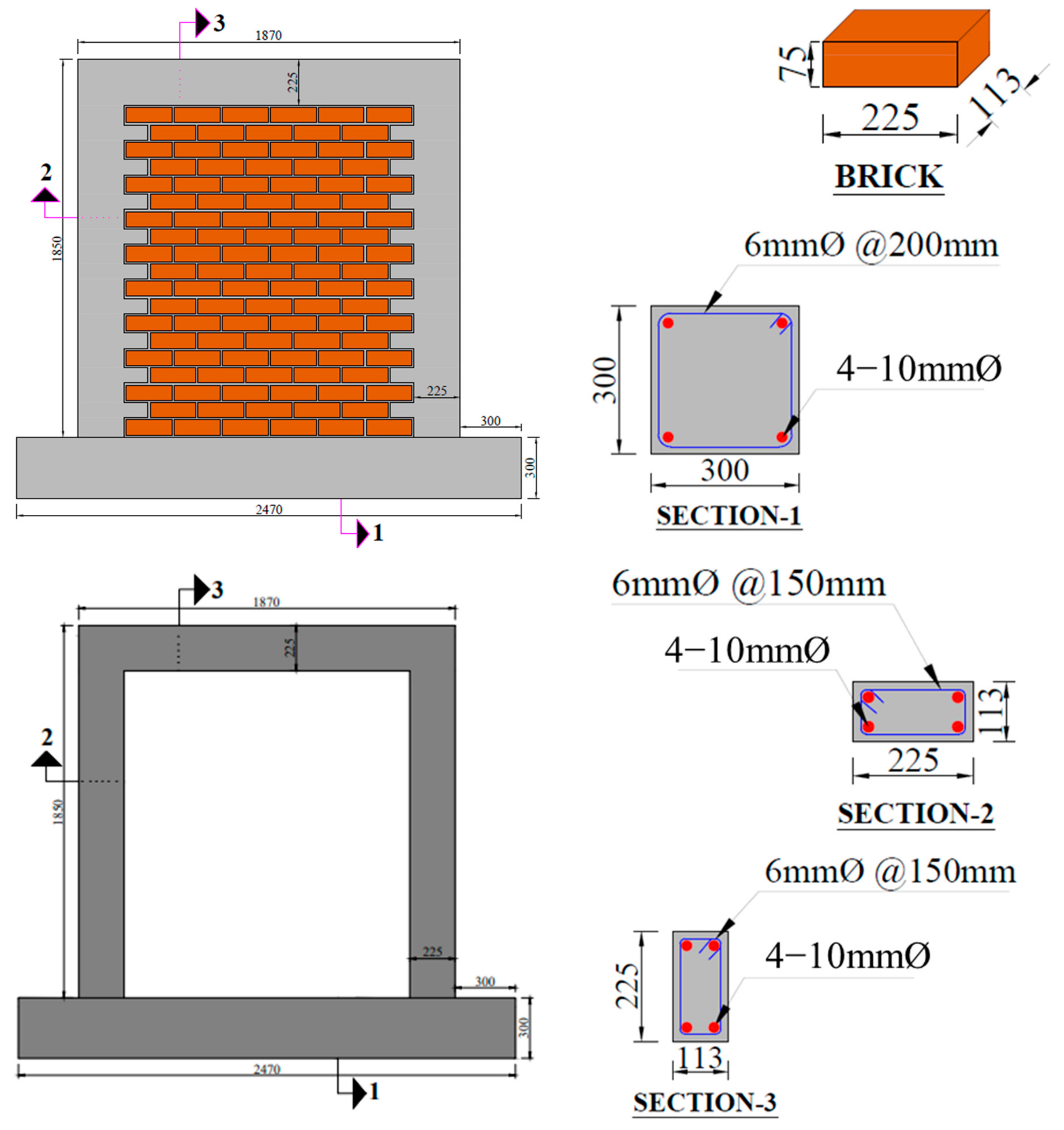
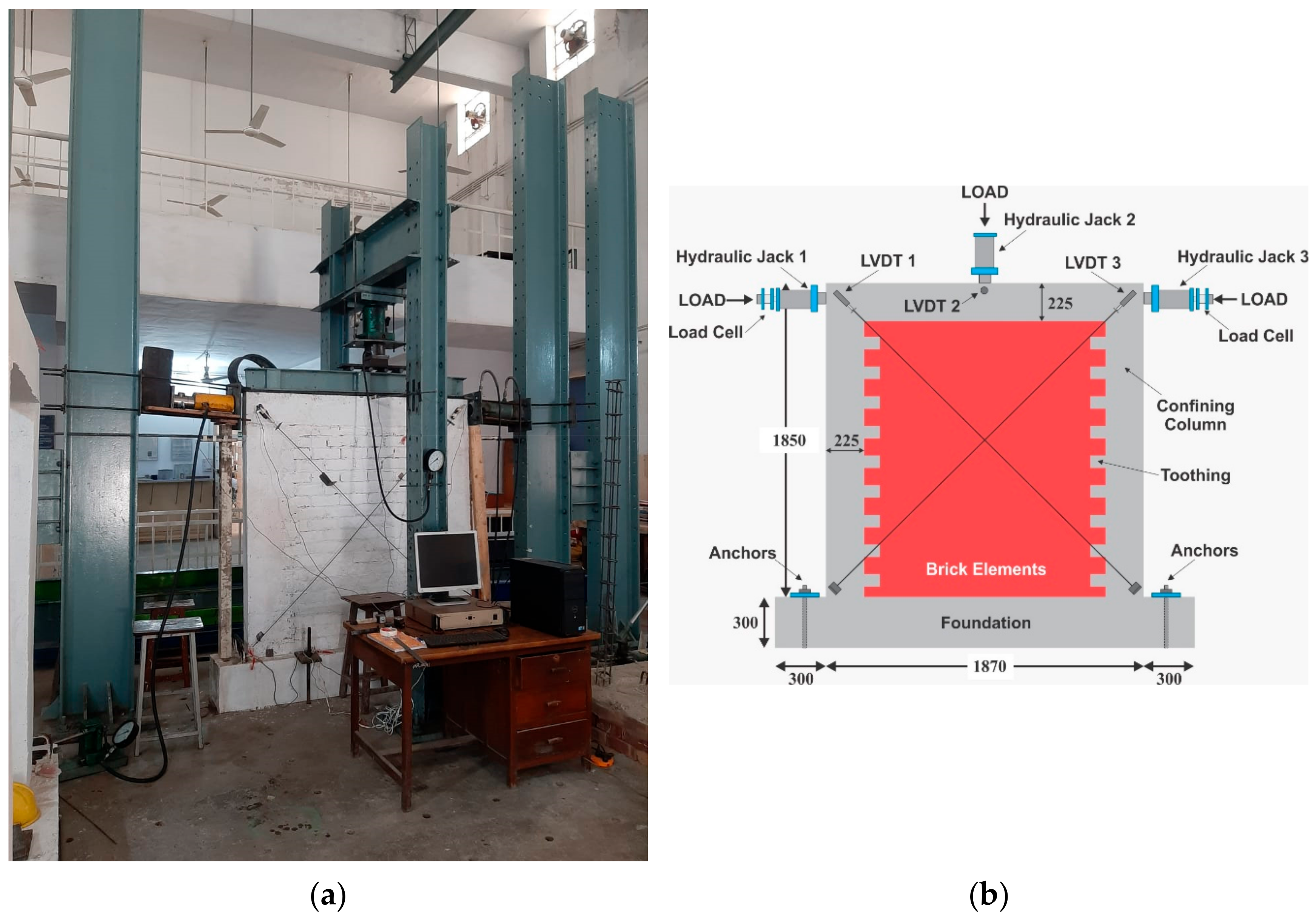
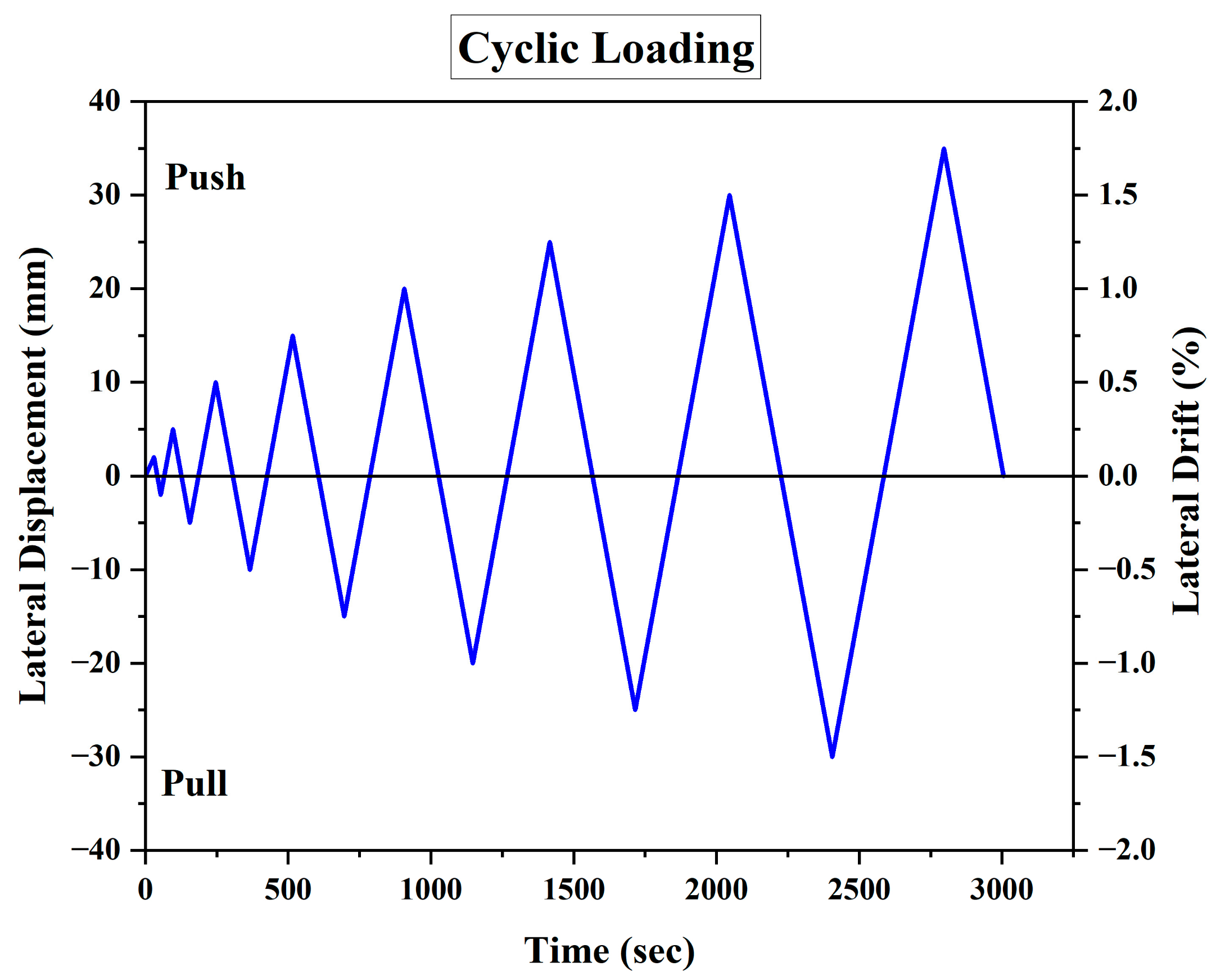
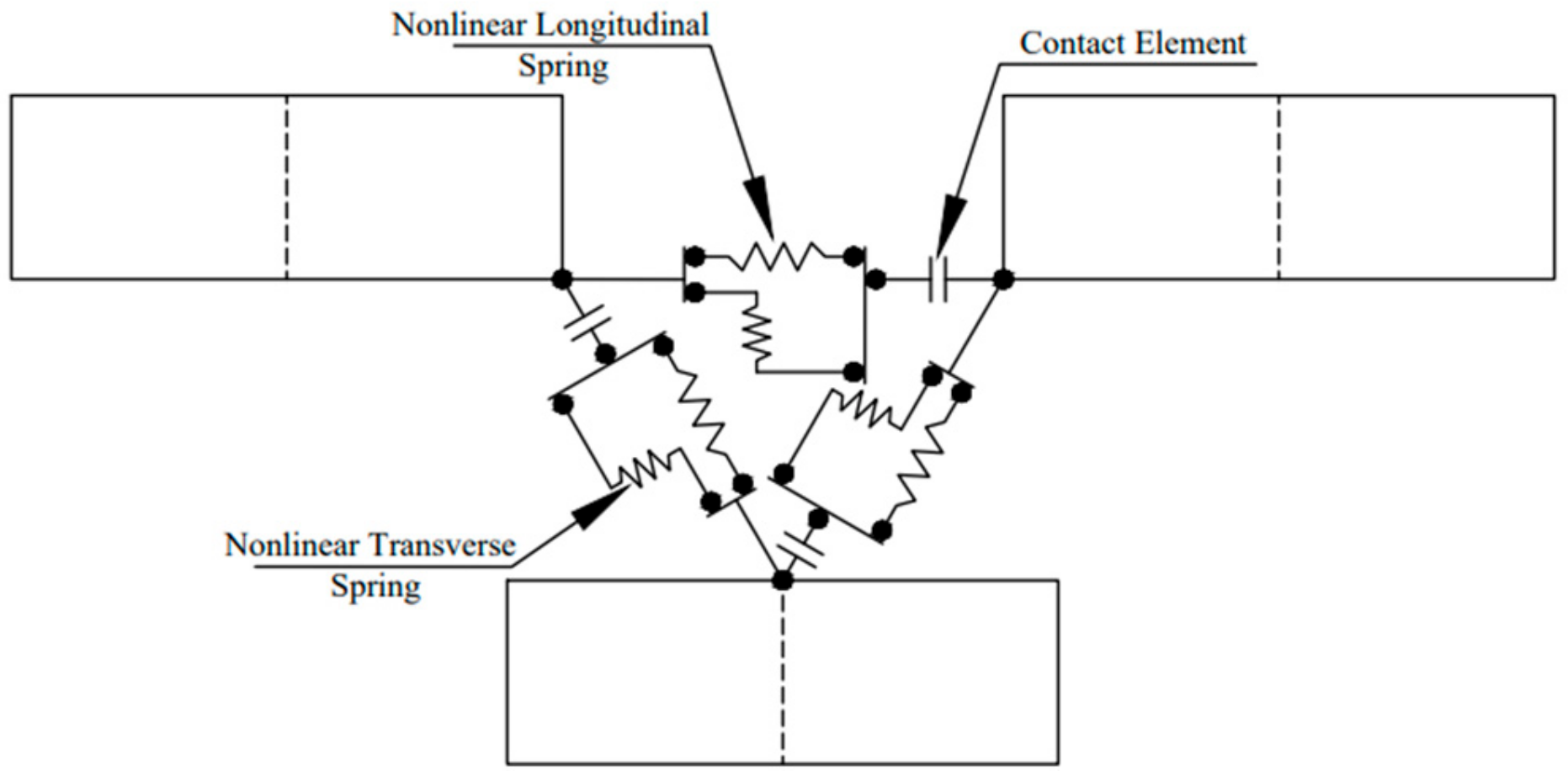
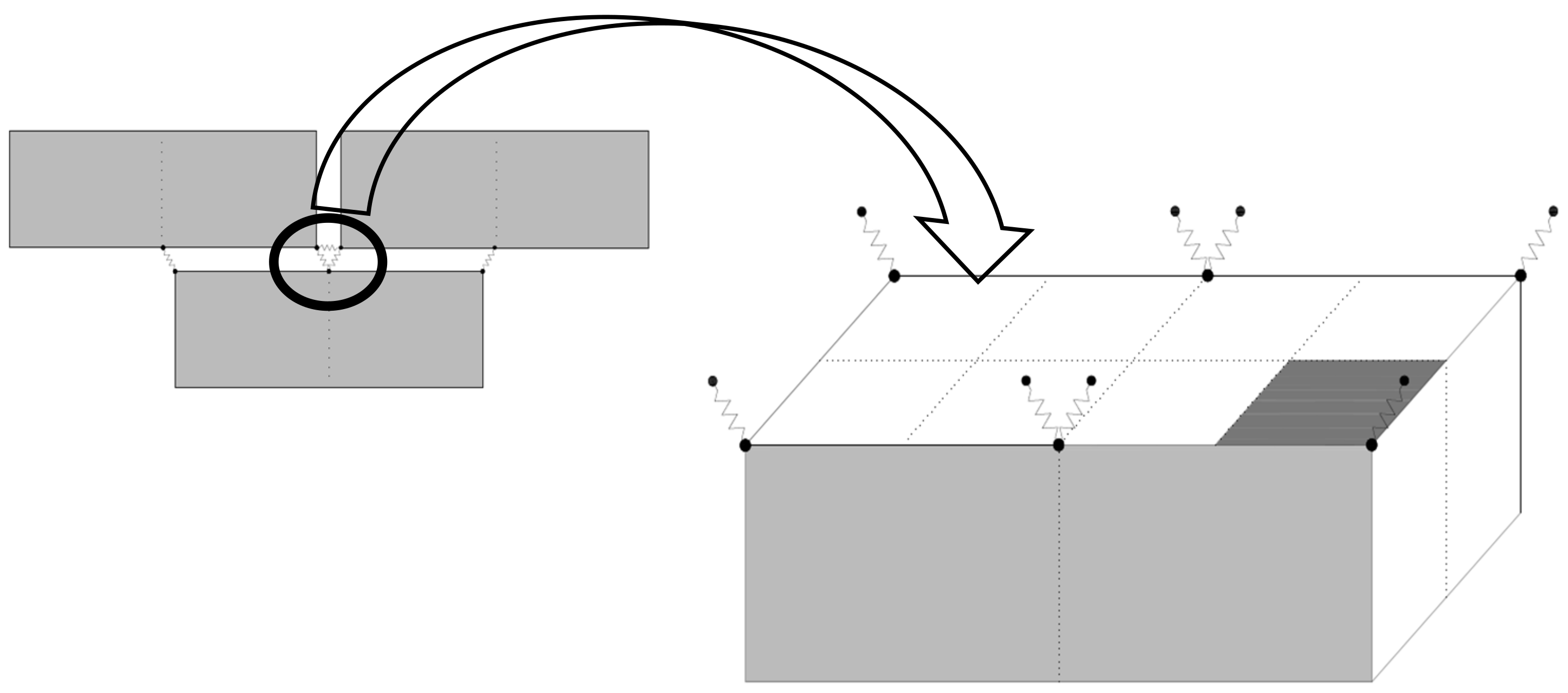
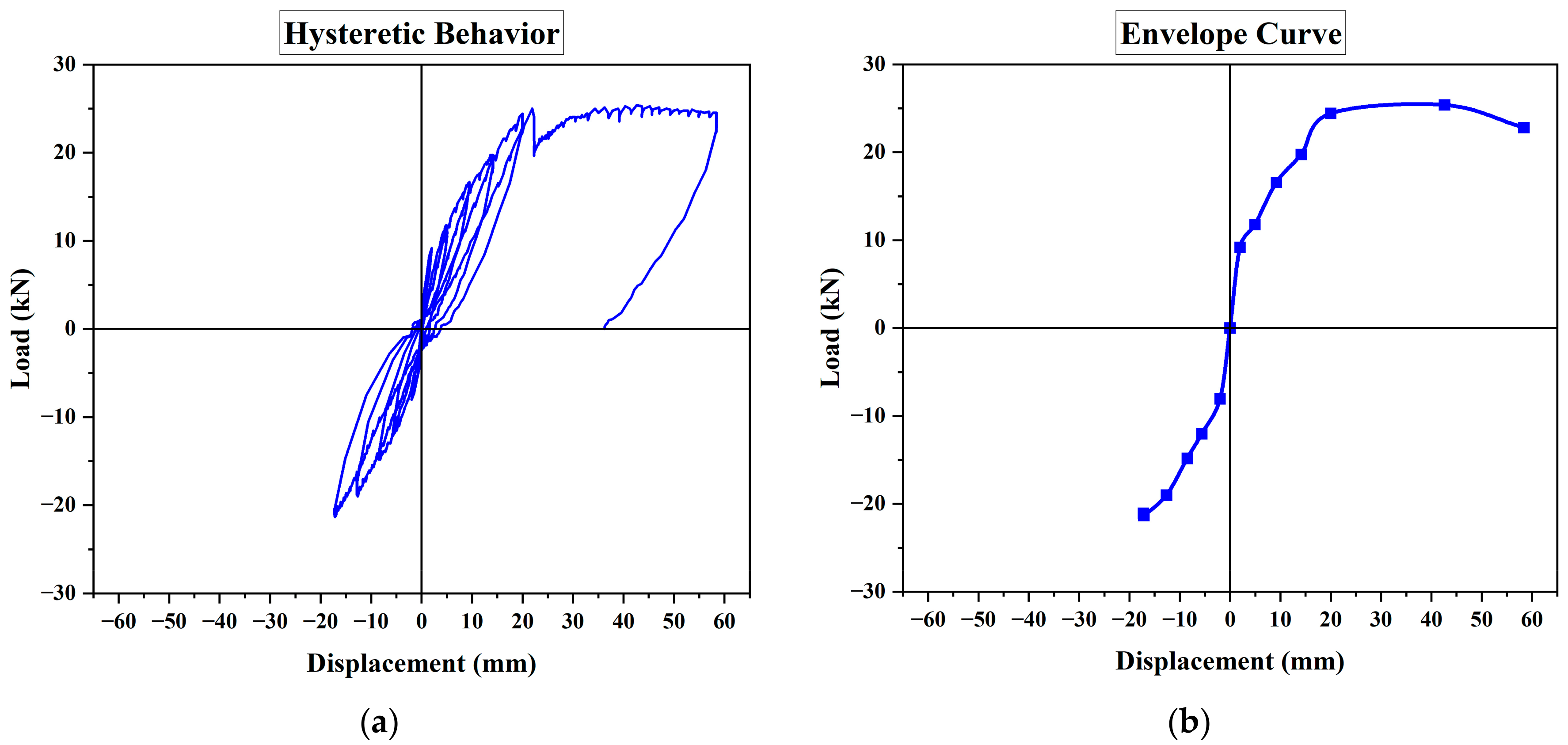

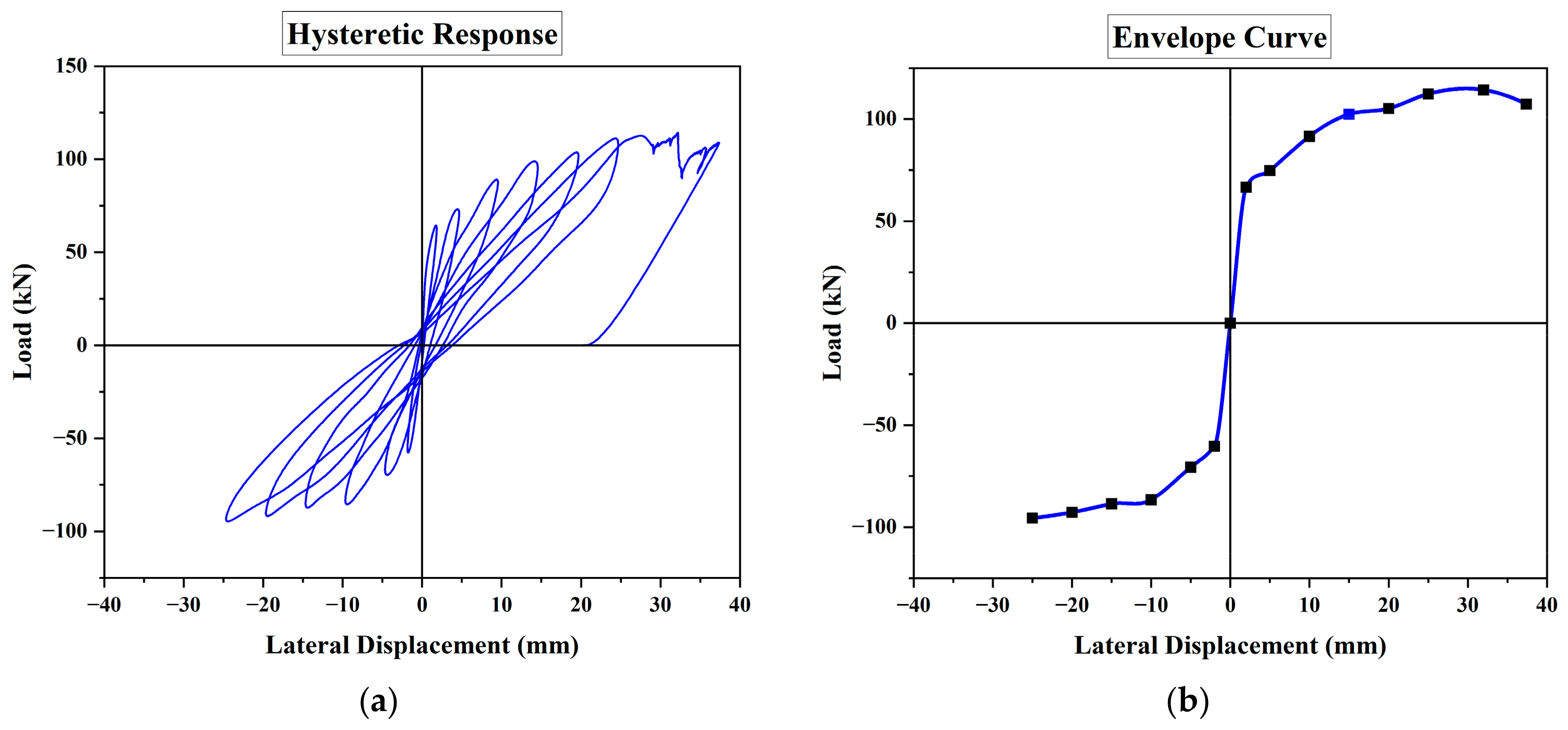
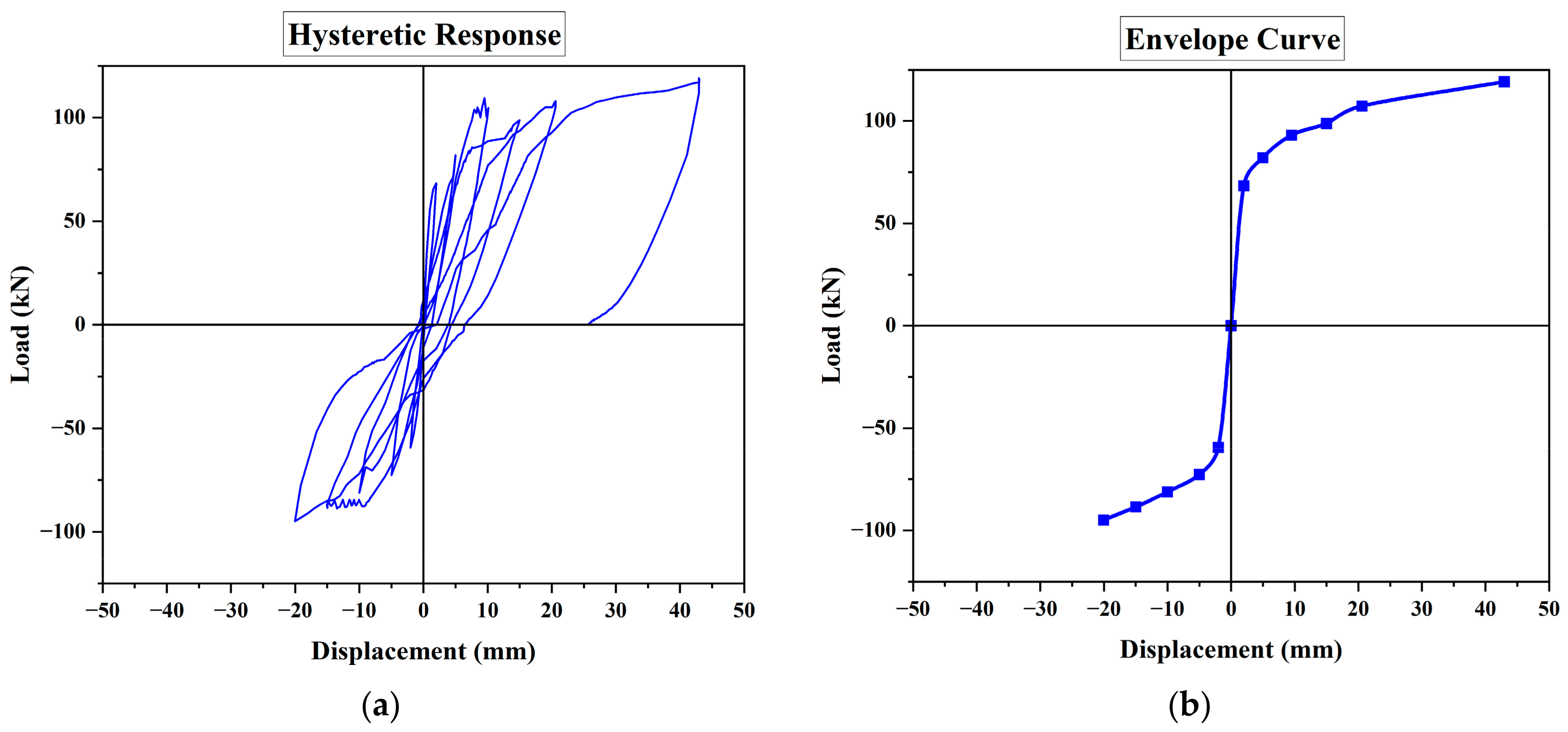
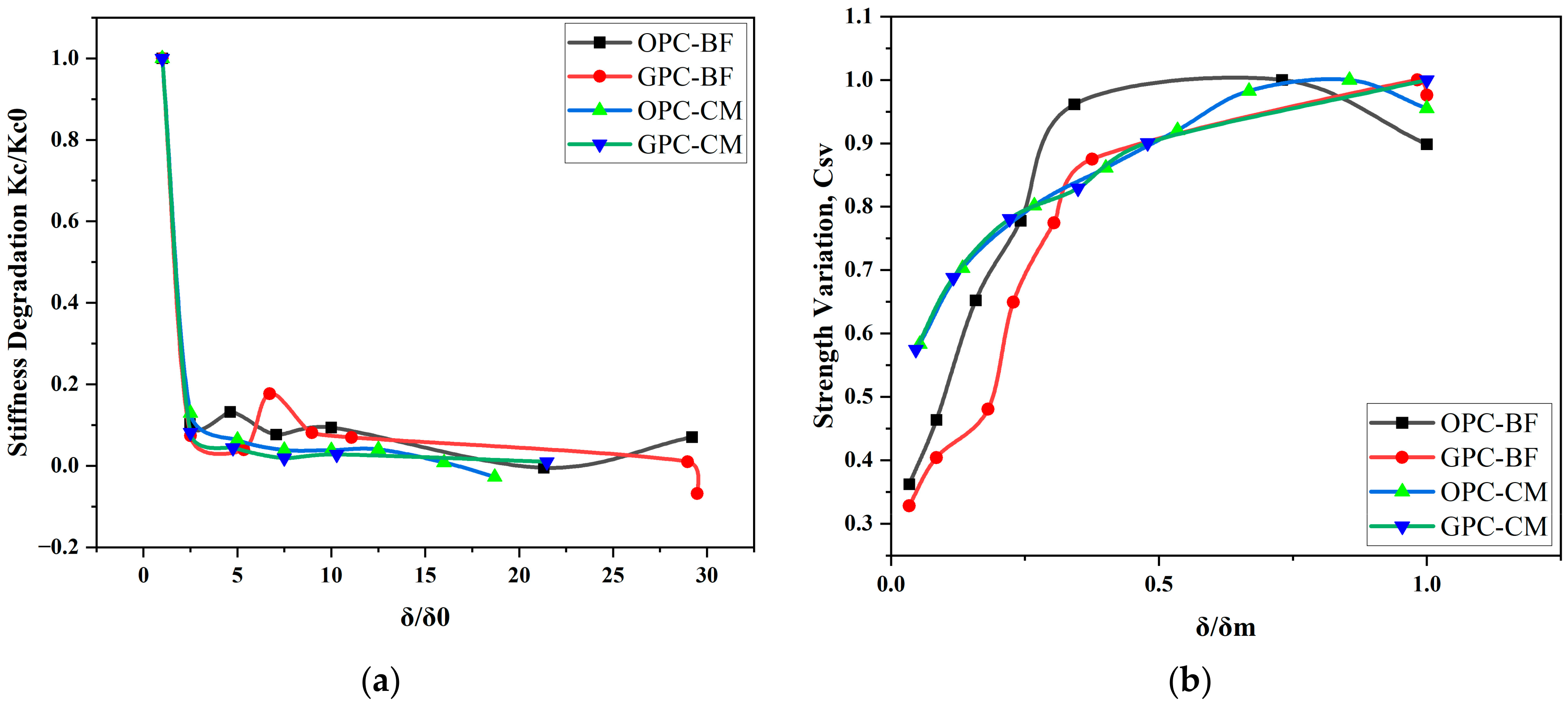
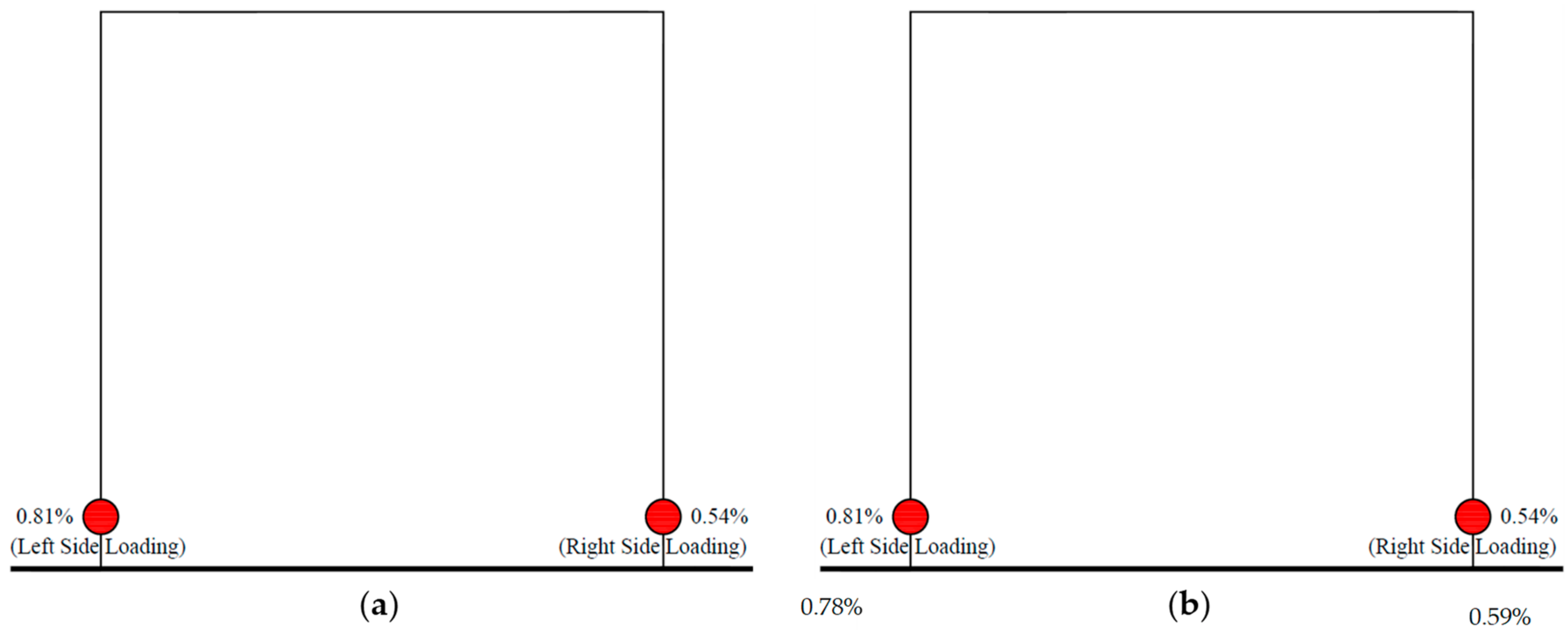
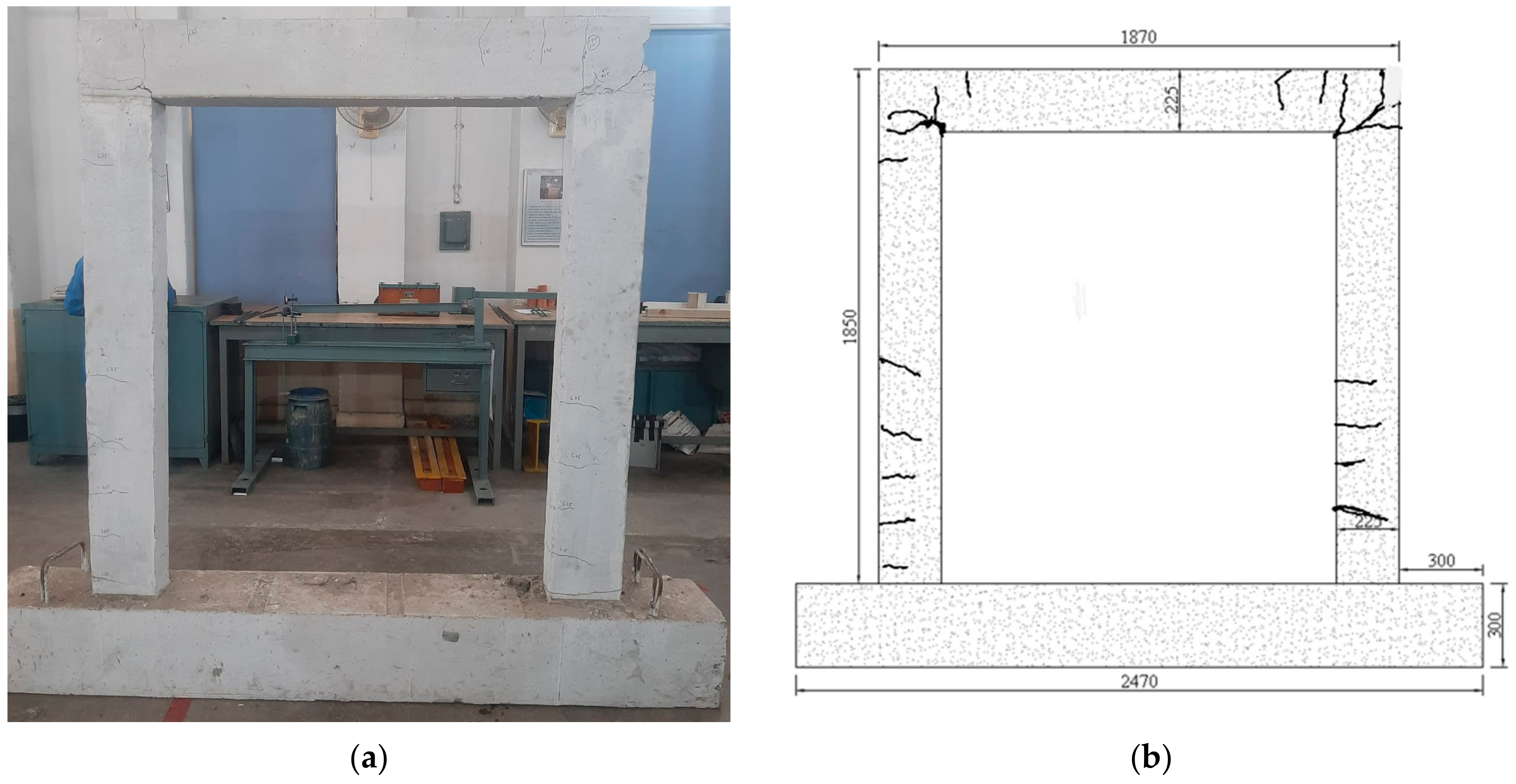
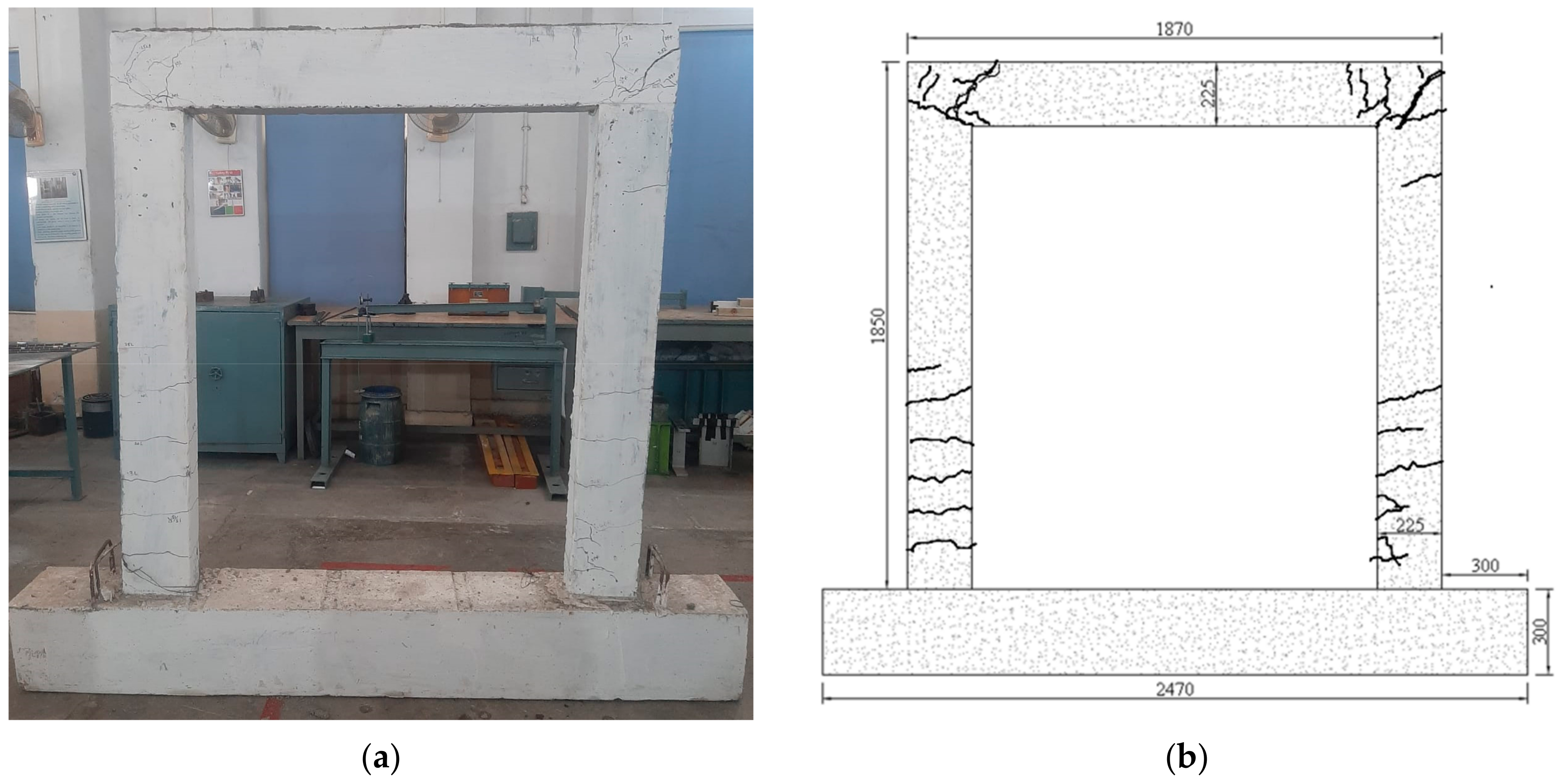
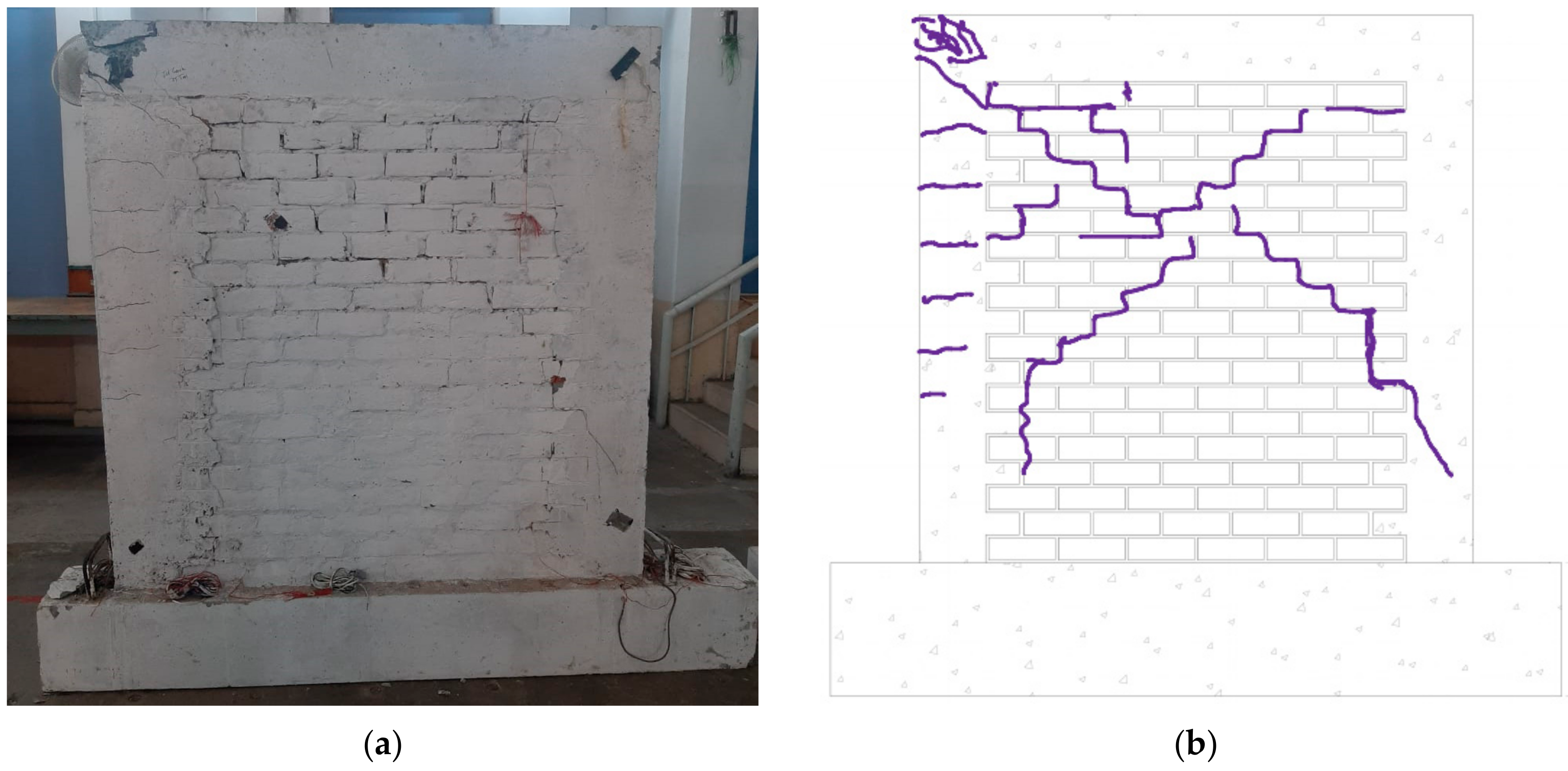

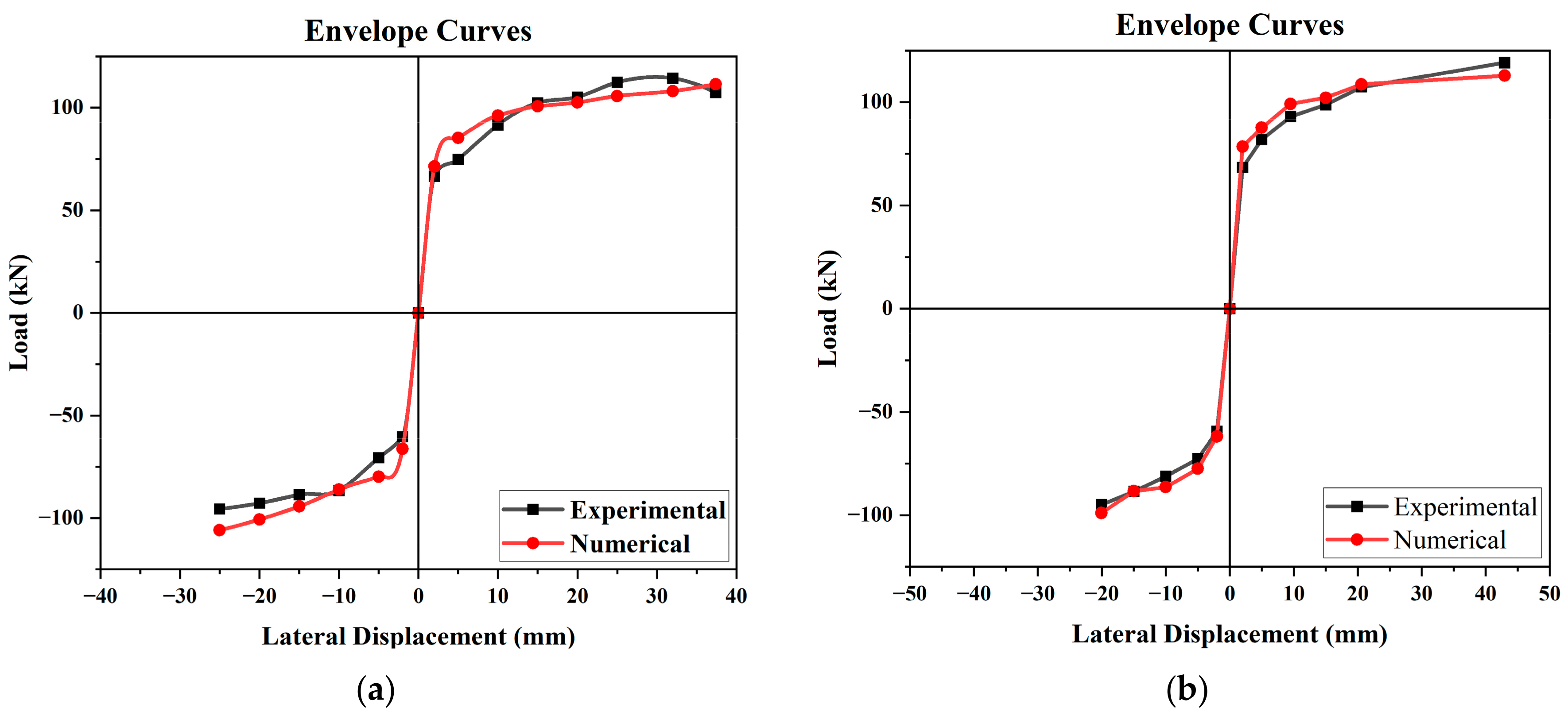
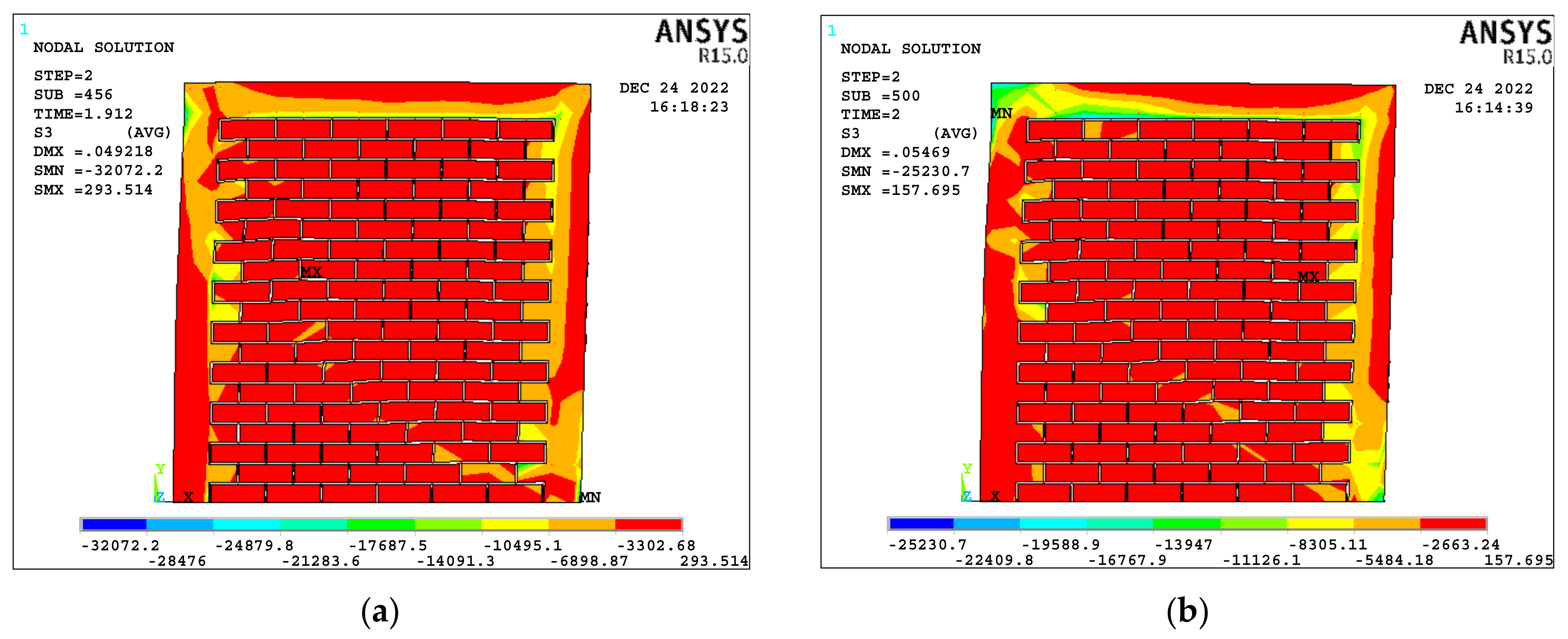
| Properties | Material | Average Value (MPa) | Reference Standards |
|---|---|---|---|
| Compressive Strength, Elastic Modulus | Brick | fb = 19.74 [COV 7.4%] | [79] |
| Cement Mortar | fjc = 21.97 [COV 6.5%] | [80] | |
| Geopolymer Mortar | fjg = 22.09 [COV 7.1%] | ||
| Masonry (with cement mortar) | fm = 9.81 [COV 8.5%] | [81] | |
| Em = 4700 | |||
| Masonry (with geopolymer mortar) | fmg = 9.78 [COV 4.9%] | ||
| Emg = 4691 | |||
| OPC Concrete | fc’ = 31.37 [COV 4.4%] | [82,83] | |
| Ec = 24794 | |||
| GPC Concrete | fcg’ = 32.96 [COV 7.2%] | ||
| Ecg = 25102 | |||
| Yield Strength | Steel Rebar | fy = 483 [COV 2.1%] | [84] |
| (6ϕ) | E = 188671 | ||
| Steel Rebar | fy = 537 [COV 1.3%] | ||
| (10ϕ) | E = 191103 |
| Category | CaO % | MgO % | SiO2 % | SO3 % | Al2O3 % | Fe2O3 % | L.O.I * |
|---|---|---|---|---|---|---|---|
| FA | 7.6 | 2.1 | 79.92 | 0.35 | 3.22 | 2.31 | 3.1 |
| Material | FA (kg/m3) | Coarse Agg. (kg/m3) | Fine Agg. (kg/m3) | NaOH Solution (kg/m3) | NaOH (M) | Na2SiO3 Solution (kg/m3) | Na2SiO3/ NaOH | AA/FA | Water (kg/m3) |
|---|---|---|---|---|---|---|---|---|---|
| Concrete | 368 | 1294 | 554 | 73.6 | 14 | 110.4 | 1.5 | 0.5 | 36.8 |
| Mortar | 368 | - | 1104 | 73.6 | 14 | 110.4 | 1.5 | 0.5 | 36.8 |
| Specimen | Vcr (kN) | Vmax (kN) | Vmax/Aw (MPa) | δm (%) | µd | ||||
|---|---|---|---|---|---|---|---|---|---|
| Push | Pull | Avg | Push | Pull | Avg | ||||
| OPC-BF | 18.52 | 25.39 | 21.34 | 23.36 | - | 3.15 | 0.93 | 2.04 | 1.29 |
| GPC-BF | 16.56 | 25.51 | 22.30 | 23.90 | - | 3.19 | 1.34 | 2.26 | 1.02 |
| OPC-CM | 75.7 | 114.3 | 98.2 | 106.2 | 0.67 | 2.02 | 1.35 | 1.68 | 15.42 |
| GPC-CM | 51.14 | 85.10 | 58.25 | 71.67 | 0.44 | 2.32 | 1.08 | 1.70 | 3.27 |
| Sr. No | Study | Aspect Ratio (H/L) | ρ (%) | Cracking Load Vcr (kN) | Maximum Load Vmax (kN) | Vmax/Vcr | Failure Mode |
|---|---|---|---|---|---|---|---|
| 1 | Ashraf [112] | 1.08 | - | - | 77.8 | - | Rocking |
| 1.08 | - | - | 103.1 | - | Rocking | ||
| 1.08 | - | 47.0 | 120.3 | 2.55 | Shear | ||
| 1.08 | - | 39.5 | 131.7 | 3.33 | Shear | ||
| 2 | Nadège et al. [113] | 1.22 | - | - | 12.0 | - | Shear-Flexure |
| 3 | A Hasnat et al. [114] | 0.75 | - | 4.42 | 13.1 | 2.96 | Rocking |
| 4 | Konthesingha et al. [115] | 1.0 | - | - | 257 | - | Shear |
| 0.5 | - | - | 345 | - | Rocking | ||
| 5 | Mojsilovic et al. [116] | 1.0 | - | - | 89.17 | - | Compression (Toe Crushing) |
| 1.0 | - | - | 145.89 | - | Compression (Toe Crushing) | ||
| 1.0 | - | - | 53.37 | - | Rocking | ||
| 6 | OPC-BF | 0.99 | 1.08 | 18.52 | 25.39 | 1.37 | Ductile |
| 7 | GPC-BF | 0.99 | 1.08 | 16.56 | 25.51 | 1.54 | Ductile |
| 8 | OPC-CM | 0.99 | 1.08 | 75.7 | 114.3 | 1.51 | Shear |
| 9 | GPC-CM | 0.99 | 1.08 | 51.1 | 85.1 | 1.66 | Shear |
| Sr. No | Study | Aspect Ratio (H/L) | ρ (%) | Cracking Load Vcr (kN) | Maximum Load Vmax (kN) | Vmax/Vcr | Failure Mode |
|---|---|---|---|---|---|---|---|
| 1 | Aguilar et al. [117] | 1 | 1.51 | 103.1 | 140.6 | 1.36 | Shear |
| 2 | Yáñez et al. [118] | 0.61 | 1.12 | 68.5 | 127 | 1.85 | Shear |
| 0.61 | 1.12 | 128.5 | 185.5 | 1.44 | Shear | ||
| 3 | Marinili et al. [119] | 0.77 | 2.25 | 142.2 | 205.9 | 1.45 | Shear |
| 4 | Zabala et al. [120] | 0.97 | 0.79 | 82.6 | 118 | 1.42 | Shear |
| 0.97 | 2.01 | 140.76 | 207 | 1.47 | Shear | ||
| 5 | Bourzam et al. [121] | 1.62 | 2.01 | 70 | 81.4 | 1.16 | Shear |
| 6 | Gavilan et al. [122] | 1.52 | 2.82 | 71.3 | 75.8 | 1.06 | Shear |
| 0.98 | 2.82 | 100.5 | 157.0 | 1.56 | Shear | ||
| 0.67 | 2.82 | 250.2 | 320.8 | 1.28 | Shear | ||
| 7 | Colunga et al. [123] | 1.00 | 1.18 | 49.0 | 80.4 | 1.64 | Shear |
| 8 | Borah et al. [107] | 1.63 | 0.72 | 34.1 | 47.5 | 1.39 | Shear |
| 1.30 | 0.72 | 38.2 | 55.8 | 1.46 | Shear | ||
| 0.93 | 0.72 | 60.7 | 81.2 | 1.34 | Shear | ||
| 9 | OPC-BF | 0.99 | 1.08 | 18.52 | 25.39 | 1.37 | Ductile |
| 10 | GPC-BF | 0.99 | 1.08 | 16.56 | 25.51 | 1.54 | Ductile |
| 11 | OPC-CM | 0.99 | 1.08 | 75.7 | 114.3 | 1.51 | Shear |
| 12 | GPC-CM | 0.99 | 1.08 | 51.1 | 85.1 | 1.66 | Shear |
| Sr. No | Study | Aspect Ratio (H/L) | ρ (%) | Cracking Load Vcr (kN) | Maximum Load Vmax (kN) | Vmax/Vcr | Failure Mode |
|---|---|---|---|---|---|---|---|
| 1 | Kuang et al. [124] | 0.60 | 2.57 | 248 | 432 | 1.74 | Shear |
| 2 | Ozkaynak et al. [125] | 0.75 | 1.00 | 48.5 | 89.7 | 1.85 | Shear |
| 3 | Van et al. [126] | 0.61 | 1.57 | 13.7 | 36.6 | 2.67 | Shear |
| 1.01 | 1.57 | 11.4 | 43.5 | 3.80 | Shear | ||
| 4 | Li et al. [127] | 0.74 | 1.09 | - | 261.1 | - | Shear |
| 0.74 | 1.09 | - | 390 | - | Shear | ||
| 5 | Durrani et al. [128] | 0.97 | 1.76 | 33.3 | 49.7 | 1.49 | Shear |
| 6 | OPC-BF | 0.99 | 1.08 | 18.52 | 25.39 | 1.37 | Ductile |
| 7 | GPC-BF | 0.99 | 1.08 | 16.56 | 25.51 | 1.54 | Ductile |
| 8 | OPC-CM | 0.99 | 1.08 | 75.7 | 114.3 | 1.51 | Shear |
| 9 | GPC-CM | 0.99 | 1.08 | 51.1 | 85.1 | 1.66 | Shear |
| Sr. No | Study | Aspect Ratio (H/L) | ρ (%) |
Cracking Load Vcr (kN) |
Maximum Load Vmax (kN) | Vmax/Vcr | Failure Mode |
|---|---|---|---|---|---|---|---|
| 1 | Jiang et al. [129] | 0.49 | 1.57 | 129.7 | 379.3 | 2.92 | ductile |
| 2 | Peng et al. [130] | 0.57 | 1.03 | - | 334.7 | - | ductile |
| 3 | Ozkaynak et al. [125] | 0.75 | 1.00 | 20.6 | 41.6 | 2.02 | ductile |
| 4 | Van et al. [126] | 1.01 | 1.57 | 7.8 | 22.7 | 2.9 | ductile |
| 5 | Penava et al. [131] | 0.68 | 2.35 | 61.2 | 106.4 | 1.74 | ductile |
| 6 | OPC-BF | 0.99 | 1.08 | 18.52 | 25.39 | 1.37 | Ductile |
| 7 | GPC-BF | 0.99 | 1.08 | 16.56 | 25.51 | 1.54 | Ductile |
| 8 | OPC-CM | 0.99 | 1.08 | 75.7 | 114.3 | 1.51 | Shear |
| 9 | GPC-CM | 0.99 | 1.08 | 51.1 | 85.1 | 1.66 | Shear |
Disclaimer/Publisher’s Note: The statements, opinions and data contained in all publications are solely those of the individual author(s) and contributor(s) and not of MDPI and/or the editor(s). MDPI and/or the editor(s) disclaim responsibility for any injury to people or property resulting from any ideas, methods, instructions or products referred to in the content. |
© 2023 by the authors. Licensee MDPI, Basel, Switzerland. This article is an open access article distributed under the terms and conditions of the Creative Commons Attribution (CC BY) license (https://creativecommons.org/licenses/by/4.0/).
Share and Cite
Ajmal, M.M.; Qazi, A.U.; Ahmed, A.; Mughal, U.A.; Abbas, S.; Kazmi, S.M.S.; Munir, M.J. Structural Performance of Energy Efficient Geopolymer Concrete Confined Masonry: An Approach towards Decarbonization. Energies 2023, 16, 3579. https://doi.org/10.3390/en16083579
Ajmal MM, Qazi AU, Ahmed A, Mughal UA, Abbas S, Kazmi SMS, Munir MJ. Structural Performance of Energy Efficient Geopolymer Concrete Confined Masonry: An Approach towards Decarbonization. Energies. 2023; 16(8):3579. https://doi.org/10.3390/en16083579
Chicago/Turabian StyleAjmal, Muhammad Mubashir, Asad Ullah Qazi, Ali Ahmed, Ubaid Ahmad Mughal, Safeer Abbas, Syed Minhaj Saleem Kazmi, and Muhammad Junaid Munir. 2023. "Structural Performance of Energy Efficient Geopolymer Concrete Confined Masonry: An Approach towards Decarbonization" Energies 16, no. 8: 3579. https://doi.org/10.3390/en16083579
APA StyleAjmal, M. M., Qazi, A. U., Ahmed, A., Mughal, U. A., Abbas, S., Kazmi, S. M. S., & Munir, M. J. (2023). Structural Performance of Energy Efficient Geopolymer Concrete Confined Masonry: An Approach towards Decarbonization. Energies, 16(8), 3579. https://doi.org/10.3390/en16083579








